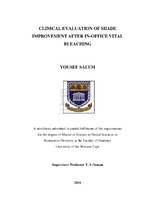| dc.description.abstract | Tooth discoloration has increased the demand by patients to pursue aesthetic treatment options. Bleaching is considered a conservative approach in performing an aesthetic treatment for discolored teeth; however colour rebound and post-operative sensitivity are among the adverse effects associated with vital bleaching. In-office bleaching systems employ the use of high hydrogen peroxide concentrations. The effects of in-office bleaching agents on the degree of colour change and the gender differences in relation to bleaching outcomes are questionable. Post-operative sensitivity can be considered a bleaching side effect and the number of patients that experience it is unknown.Aim: The aim of this study was to assess the outcome of an in-office vital bleaching technique. Objectives: The objectives of this study were to evaluate the degree of colour change after vital tooth bleaching using a 35% hydrogen peroxide gel (Yotuel® Special, Biocosmetics Laboratories, Spain), using a spectrophotometer (CM-2600d Konica, Minolta) to measure the colour change at each intervention during the bleaching process, to assess the post-operative sensitivity during the first week of the intervention, to evaluate the patients' perception of the colour change and to compare it to the colour change (ΔE) expressed in numeric values and to investigate whether gender differences exist in relation to the outcome of the bleaching procedure. Materials and Methods: The maxillary anterior teeth of 22 patients comprising of 11 males and 11 females were bleached with a 35% hydrogen peroxide gel (Yotuel® Special, Biocosmetics Laboratories, Spain). Pre-treatment readings of the two maxillary central incisors using a spectrophotometer (CM-2600d Konica, Minolta) were obtained. Subsequent readings were obtained after scaling and polishing, before bleaching (which was used as a baseline reading), immediately after bleaching, one week and one month post-operatively. Patients were requested to complete a form regarding post-operative tooth sensitivity and their colour perception toward the bleaching treatment. Results: The quantitative effect of the bleaching material on tooth colour showed an increase in L* values and a decrease in a* and b* values, the changes were significant (p values ≤ 0.05) except for the mean value of b* one month after bleaching which was only significant between five and ten percent.The mean values of colour change measured as ΔE between baseline and after bleaching was found to be 3.4 which did not exceed the visible colour change perceptible clinically at a difference of 3.7 units according to the literature. However nine patients exceeded the visible clinical colour change immediately after bleaching. There was no gender difference in the ΔE values in the entire bleaching process. Tooth sensitivity is considered a bleaching side effect and in this study sensitivity was traced until the fifth day after bleaching. The mean value of patients' tooth sensitivity was found to be 1.73 in the first day on a 4 point visual analog scale. The mean value of patients' colour perception was found to be 2.14 immediately after bleaching on a 3 point visual analog scale. Spearman correlation tests showed a positive relationship between ΔE values immediately and one week after bleaching and a weak relationship one week and one month after bleaching. There was significant consistency in the patients‟ colour perception data immediately and one week after the bleaching process and a weak relationship between ΔE values and patients' colour perception one month after bleaching. Conclusion: Yotuel® Special, Biocosmetics Laboratories, (Spain) an in-office bleaching material consisting of 35% hydrogen peroxide was able to bleach patients' teeth with a perceptible colour change however the chalky white teeth desired were not obtained for all the patients. Tooth sensitivity was a temporary side effect. | en_US |

